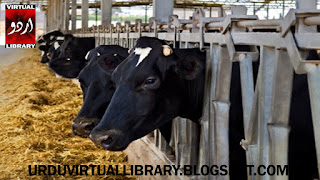Wheat Straw Treatment
HUSSNAIN ZAHID
AHSAN SALEEM
WASEEM HASHIM
KBCMA COLLEGE OF VETERINARY AND ANIMAL SCIENCES
(UVAS SUB-CAMPUS),
NAROWAL
Introduction:
Straw is most abundant of all agricultural resides. It is
composed of cellulose and hemi-cellulose. These are bound to lignin and
resistant to microbial attack. It is used for burning, making paper as poor
quality roughage which is given to cattle, buffalo (Ruminants). It is deficient
in nutrification and has ability to digest slowly in ruminants. It is
alternative source of nutrition for live-stock animals but wheat straw alone
does not give proper nutrition to animals which they require. That’s why wheat-straw
is treated with urea.
Method:
Nutritional value of wheat-straw (which is low protein and
low digestible roughage) can be improved through physical or chemical methods.
Efficacy of treating straw with urea for improving its nutritive value is
considered equivalent to aqueous ammonia. However, adoption rate of
urea-treatment by farmers is low. So, there is need to simplify urea-treatment
methods.
The new method involves weighing
required amount of urea (4% of straw) mixing it with double the amount of farm
manure (as a urease source) giving 30% moisture in a bag, pilling the straw on
the bag, again moistening the straw with water (50%) of straw and incubating
this material for one month under the cover of plastic sheet or mud-plaster can
save labour by 55%.
Method of Spraying:
For spraying of urea solution over a
layer of 100kg straw or whatever quantity that is chosen, gardeners’ sprinkler
can be used to achieve uniformity in solution coming in contact with straw. For
chopped wheat straw, some hand mixing after the spray of urea solution is
desirable.
Compactness of Stack:
⮚
If 1 layer of 100kg has been treated, an
additional layer of 100kg is placed on top and sprayed with urea. A compact
stack has two advantages.
⮚
Firstly, effectiveness of ammoniation process
is better
⮚
Secondly, there are less chances of mould
growth which leads to spoilage of the straw. Better the compaction and
airtightness of attack better will be quality of treated straw.
Storage Method:
Covering of the stack is important,
though particularly the larger and more densely packed stacks could be open
i.e. covered with only a layer of untreated straw. Sealing can be done with
polythene, coconut or banana leaves or empty urea-bags stitched together.
When small heaps are treated it
becomes important to have stack adequately sealed.
Effect of Treatment on Straw Quality:
Urea treatment improves straw
quality in terms of digestibility and intake treated straw positively affects
animal production and health.
Nutritive Value:
Treated straw increases the crude-protein content in order of
4 to 5 percentage units due to addition of ammonia. The higher intake and
digestibility is due to increased rate and extent of cell wall degradation.
Effects of Treatment on
Straw
|
Straw Type |
US/TS |
DMI |
DDMI |
DOMI |
DMD |
OMD |
IVOMD |
|
Wheat |
US |
63-64 |
35-38 |
0.86 |
39-40 |
40-41 |
44-47 |
|
|
TS |
71-84 |
50-76 |
1.36 |
42-50 |
43-53 |
51-83 |
Animal Health:
Generally, it can be said that by replacing a large amount of
Untreated Straw (US) by Treated Straw (TS) in the ration:
⮚
Butterfat increases to some decimal
points.
⮚
Milk yield increases of 0-1.5 liters, but
0.5-1 liter appears to be a reasonable range depending on other feeds fed stage
of lactation and body weight of animal.
⮚
Animals of 100-150kg body weight will lose
50-100g/day if fed on only US, whereas they will gain 50-100g/day when fed on
TS alone.
⮚
In some cases, by feeding animals on TS
dung gets slightly stickier.
⮚
Urea toxicity due to feeding of treated
straw (TS) is unlikely or even impossible because straw and urea are well mixed
and intake of straw is slow.
⮚
Fungal growth in straw can produce mycotoxins which cause abortion or other ill effects but ammonia produced from urea while
treating straw is efficient to inactivate
the mycotoxins.
⮚
Vitamin A deficiency in treated straw and
untreated straw can cause fertility problems in cow, but this can be prevented
by including some green fodder in
ration.
⮚
Skin becomes shiny when animals are fed
upon TS.
Limitations of Wheat
Straw Treatment:
⮚
When straw availability is low/limited
some formers get discouraged because stack of straw gets exhausted quickly.
⮚
A farmer who uses urea on credit or other
limited resources prefer to use urea on cash crop rather than treatment of
straw, where returns are low.
⮚
For large dairy farmers, straw
availability and labour may be problem.
Conclusion:
⮚
Urea treatment improves nutritive value of
straw in terms of total content, energy
digestibility and intake.
⮚
Crude
protein
content increases.
⮚
The effectiveness of treatment depends
upon:
a)
Type of Straw
b)
Concentration of Urea
c)
Moisture Level
d)
Method of Spraying
e)
Method of Storage
Technology
can be adopted where:
⮚
Grasses or other green fodder are not
available.
⮚ Straw is cheap and readily available.
 |
| Wheat Straw Treatment |












0 Comments